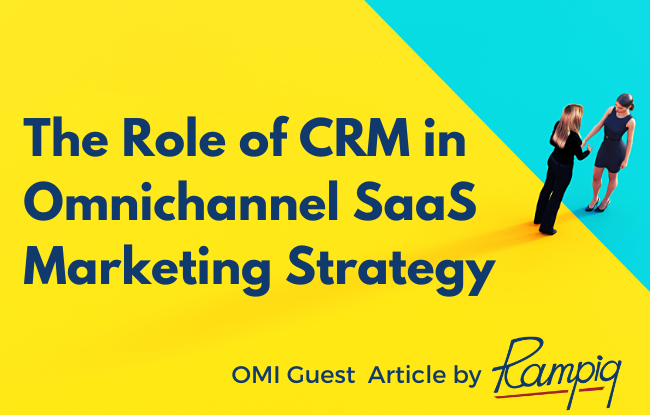What is an omnichannel marketing strategy?
Omnichannel approach gives businesses the opportunity to be present on multiple platforms at the same time. With a multichannel strategy, you’re just present on several channels, for example, doing some SEO and doing some paid ads at the same time. The omnichannel approach lets you add a lot of integrity into how you communicate with your customers across all the channels, all devices and all the platforms. You use the unified messaging, strategically chosen visuals and consistent marketing materials. Moreover, you can apply integrated communication standards regardless where you talk to your customers, via email, or via WhatsApp.
Being omnichannel lets you be more relevant to your target audience and your brand presence becomes more unified and more cohesive. Omnichannel strategy has a goal to create a consistent brand interaction experience for your audience. This is the way you introduce a seamless experience for consumers and you offer them multiple ways to get in touch with you across devices, platforms, websites, and media that they naturally use. The key philosophy of the omnichannel marketing strategy is to adopt and implement a consumer-centric marketing approach.
Features of an omnichannel marketing strategy
The omnichannel gives you an opportunity to be there for your customers exactly when they need you and in the most convenient way for them. Here are the key features of the omnichannel marketing strategy:
- Multiple ways to interact with your customers.
With omnichannel, you market to your customers across a variety of platforms and devices. And you also give them a way to interact with you and your brand on social media messengers, on email, via customer service hotlines, and live chats.
- Personalization.
The omnichannel marketing strategy adds a lot of personalization to your brand and to the way you do your marketing. You definitely become much more personal in communicating with the audience because you can much easier identify people across the channels, and you can literally tailor your content and communication approach on the fly, depending on your past history of interacting with the same customers in the past.
- Consistency.
With this approach, you become more consistent in your brand tone of voice, and more identifiable. Omnichannel adds extra touchpoints to your user journey, and this is your chance to be relevant and helpful at every step of their way.
Why SaaS businesses are adopting an omnichannel marketing strategy
Omnichannel strategy was originally adopted by retailers who wanted to make sure that they are using every channel possible to communicate and market to their customers. For SaaS companies, sales and marketing space becomes more crowded. So now it’s high time to adopt an omnichannel strategy if you are a SaaS company. This is how you can become more accessible, more relevant and more consistent in how you communicate with your prospects.
And this is also a game changer in how you actually do your marketing: you become more streamlined in your messaging and increase the amount of touchpoints naturally, which positions you in the very right way for your prospects.
Factoring a CRM into omnichannel operations
CRM is a critical system for the omnichannel operations delivery. In fact, you can’t really implement the omnichannel strategy without a CRM. Nowadays, CRM is the single platform that stores all the history of your interactions with your prospects. You can store all the touchpoints, and all the devices, and platforms, and other ways you communicate with your prospect. Your CRM is the system that accumulates a lot of information about how you build a relationship with a particular prospect and what is the most convenient way for them to actually interact with you. And this is how you can become really personal in your conversations, as a good CRM will give you a ton of information about which content that person viewed, which brochures or which gated content they touched with, what they downloaded, how many touchpoints they had before they started talking to you.
At later stages of your customer journey, when it comes to interaction with your sales people, and then afterwards with your service lines and customer support representatives, the CRM component becomes a super powerful tool to build a strong relationship with your clients. With CRM, you can store all the information about your prospects from day one. If you add the omnichannel component to tracking and facilitating your customer journey, you’ll empower your team with multiple ways to reach out to your customers. And you will give your business a ton of useful information and much better ways of how you can structure your audience and segment it. This is where you can source the insights that you can use on multiple business levels, starting from the messaging in your ads or your website, and boiling it down to customer support representatives scripts.
How does an omnichannel marketing strategy benefit SaaS businesses?
Implementing an omnichannel marketing strategy for SaaS businesses is the foundation of your customer engagement. And this is also a good way to make more informed decisions about what you need to tune in your sales process, product performance, and support team performance. This approach can easily facilitate better team interaction and it can also help you be more effective with your customer service. CRM gives you ideal tools to implement this approach, and the end result is more satisfied customers, and more sustainable retention rates for your product.
The omnichannel approach means that you can be present in a mobile app, in an email, in SMS, in a chatbot on social media, and even on WhatsApp for business. And you can deliver a seamless customer experience across all platforms by adding an extra layer of data from your website interactions and product in-app activity with your customers when you blend this all together. This is how you get to know your prospects, your customers so much better, and you can then deliver more tailored and curated information at every stage of their journey.
You will also have a better customer reach because you will be present across all platforms. And you will also expand your reach by adding personalization to every interaction with the help of a CRM system. This lets you create a more consistent and more personalized approach to individuals, not just line items or records in CRM, but real people.
Let me give you a practical example. I downloaded a brochure from one of the marketing automation software firms and then visited their website a couple of times. With the help of their CRM, they figured that I’m a Mac user. And, as I interacted with their content quite a lot, they carefully segmented me as a bottom-of-the-funnel prospect. Their next step was to reach out to me and offer AirPods Pro for visiting their software demo session.
This is a great example of omnichannel approach implementation:
- They knew which content got my attention,
- They knew that I am a Mac user, so they didn’t incentivize me with Android products,
- They knew that I’m holding a C-level position so their marketing messaging was very spot-on,
- They got me to their SaaS product demo in an elegant way, and actually the cost-per-demo wasn’t too high in my case!
Best practices for creating an omnichannel marketing strategy
- Have a solid action plan. As with any company-wide initiatives, you need to plan the systems, the process, and the people around omnichannel implementation.
- Engage company stakeholders. Ideally, you need to make sure that all teams (marketing, sales, support, IT) are informed and heavily engaged in the omnipresence delivery initiative.
- Be consistent and train your people. Omnichannel is aimed at providing the best experience not only for your customers, but also for your employees. Provide them with training and make sure the onboarding to new systems is smooth for them.
- Use the proper technical stack. Make sure that your team members are fully onboarded and know how exactly they need to use the CRM components and modules in order to provide the best customer experience.
Top CRM personalization features for SaaS
Leveraging CRM for omnichannel marketing strategy delivery depends on the personalization features the CRM can provide. Let’s review top SaaS CRM’s options for making your customer experience personal and appealing:
| CRM system/product | Personalization feature | Value |
| Salesforce/Salesforce Marketing Cloud
|
Personalization Strings | Lets you insert subscriber attributes, such as subscriber name, job role, company name into your emails to make your communication very personal |
| Dynamic Content Display | Content that is displayed in the content area based on the rules that you define according to the subscriber’s attributes or the targeted data extension column values. It’s a great option for non-technical marketers to deliver personalized content using the rules-based interface | |
| Enhanced Dynamic Content | If you are designing emails that extend beyond just a couple of rules for swapping dynamic content, the Enhanced Dynamic Content tool lets you import a file with delimiters containing text and image URLs to create content. Instead of using AMPscript and data extensions to manually create complex dynamic content and the rules for each variation, the system creates the content from the data in your imported file. | |
| Microsoft Dynamics | Reference previous engagement | With Dynamics 365, you can keep track of all past activities including phone calls, e-mails, bookings and appointments, and build a great rapport with your customers and reference previous customer engagements with ease. |
| Target by Customer Location | If you want to let your audience know about a promo or an event that’s only relevant for certain regions or territories, Microsoft Dynamics 365 ensures that your customers only get messages that are relevant to their location. | |
| Offer Multiple Customer Service Channels | Customer preferences differ across regions, sectors, and even across the same customer at different times. While some customers like to get help via live chat, others might send an email, and several others might even want to talk to a customer service representative on the phone. No matter what the channel, Microsoft Dynamics 365 enables you to save preferable contact methods for leads and contacts. |
This article gives more in-depth review of Best CRMs for SaaS.
About the author

This blog post is brought to you by Liudmila Kiseleva, CEO of Rampiq.
Liudmila is one of the best-in-class digital marketers and a data-driven, very hands-on agency owner. With top-level education and experience, Liudmila is a true expert when it comes to digital marketing strategy planning and execution.
